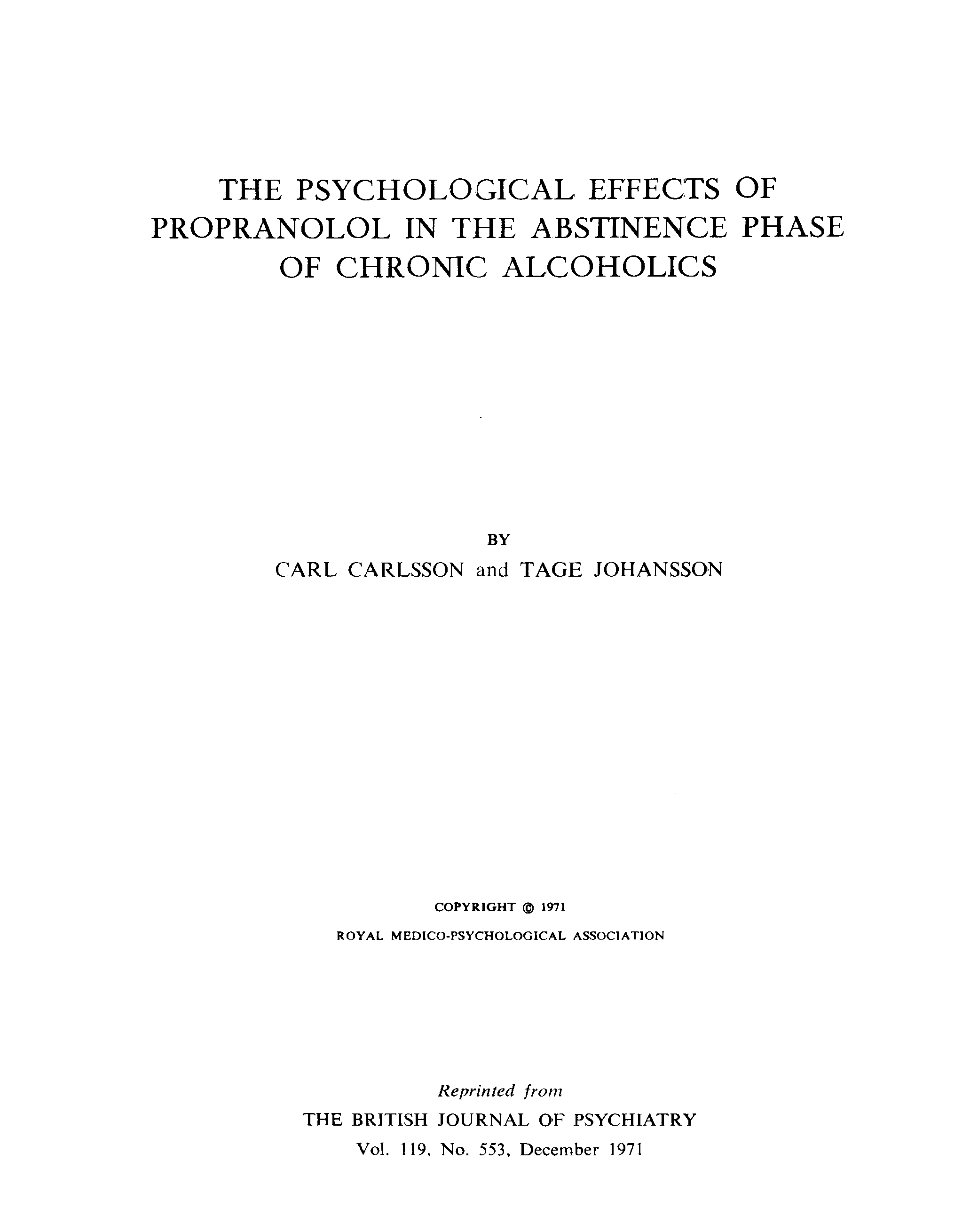
__________________________________________________________________________________________
Brit. J Psychiat. (1971) 119, 605-6*************************************************** ABSTRACT
The Psychological Effects of
Propranolol in the
Abstinence Phase of Chronic
Alcoholics
By CARL
CARLSSON and TAGE JOHANSSON
|
In a previous study hyperkinetic circulation was
found in alcoholics in the abstinence phase. Normal conditions were restored
by 40 mg. propranolol. Even tension symptoms decreased (Carlsson,
197l). MATERIAL AND METHOD The
material consisted of 44 male chronic alcoholics (alcoholic addiction)
admitted to a mental hospital and aged 29-54 years (mean 42). The dropout was
4 patients in each group. Initially
all alcoholics with abstinence symptoms were treated with chlormethiazole
(Hemineurint). The aim was to give the lowest
possible dose. The patient generally had Severe symptoms of tension during
the first few days, despite medication. Diazepam was also given sometimes,
but owing to the risk of' habituation the aim here too was to give as little
as possible. It would have been desirable to give only propranolol or
placebo. However, the drop-out would then have been much greater, since the
ward does not treat alcoholics behind closed doors or against their will. The
treatment other than propranolol is given in Table I. The
patients were examined twice by the psychologist (T.J.), the first time a few
days after the patient had been admitted to the ward, and then after eight
days on propranolol 40 mg (Inderal®) 4 times
daily or placebo. The patients were given 56 questions at both times, from
which were selected before the study 7 questions about tension, 8 about
depression and 6 about dysphoria (irritability). |
TABLE I Treatment other than propranolol or placebo
during the 8 days of medication _______________________________________ Total dose for----------------
Total dose for The placebo group***** the propranolol group n = 18 ---***--------------n = 18 _______________________________________ Diazepam (Valium®) ***395 mg *******230 mg Chloralodol (Mecoral®)
*75.2g *******102.4 g Phenytoin (Difhydan®) ***2.4 g**********2.1
g Chlormethiazole ********* 8.1 g ********20.7g (Hemineurin®) _______________________________________ RESULTS In the presentation of the results of the
psychological examination, (Table II), all improvements are expressed in
positive figures. Thus, the higher the figure the greater the improvement.
There was a significant decrease in tension symptoms. In two cases
bradycardia was noted (propranolol group). DISCUSSION The theory previously reached in an uncontrolled clinical study that propranolol has a selectively stress-relieving effect on the symptoms of alcoholics seems to have been confirmed, and the effect is often marked. There is no effect on dysphoric |
TABLE
II
Difference in points between questionnaires before and
after 8 days of medication (calculated from total points for all patients)
______________________________________________________________________________________
|
Tension _______________________ placebo
**** propranolol 22 ********** 61 n = 18 ****** * n = 18 0,01 < P < 0,05 |
Depression ___________________ placebo
****** propranolol 11 ********* 70 n = 18 ****** * n = 18 0,05 < P < 0,10 |
Dysphoria ____________________ placebo ****** propranolol 33 ********** 27 n = 18 ****** * n =
18 No significance |
Tension
+ Depression _____________________ placebo
****** propranolol 33 ***********131 n = 18 ****** * n = 18 0,01 < P < 0,05 |
_________________________________________________________________________________________
Kolmogorow - Smirnow two-sample test.
603
================================================================================
606 PSYCHOLOGICAL EFFECTS OF PROPRANOLOL IN THE
ABSTINENCE PHASE OF CHRONIC ALCOHOLICS
|
Symptoms. The doses of other preparations were
fairly small (Table I), and it is improbable that the difference could be due
to this. In a double-blind trial propranolol was found more
effective than placebo in the treatment of anxiety (Granville-Grossman and
Turner, 1966). Wheatley (1969) found propranolol as effective as chlordiazepoxide in the treatment of anxiety. High
dosages of propranolol on laboratory animals have shown depressive effects on
the central nervous system (Leszkovsky and Tardos, 1965). The
mechanism of action of propranolol in the present study is of course partly
peripheral, according to previous findings (Carlsson,
1971), but this can hardly be the whole explanation. Propranolol passes the
blood-brain barrier and accumulates in various cerebral structures (Black et
al., 1965). One can speculate whether the effect on the brain may be due to
blockade of beta-adrenergic receptors. There are several studies indicating
that betaadrcnergic receptors exist in the central
nervous system (Connor et al., 1967). |
There
is no doubt that propranolol has a decreasing effect on tension symptoms,
which clinically we have often found of great value. REFERENCES BLACK, J. W., DUNCAN, W. A. M., and SHANKS, R. G.
(1965) . 'Comparison of some properties of pronethalol and propranolol.' Brit. 7. Pharmacol.,
25, 577-91. CARLSSON, C. (1971). 'Haemodynamic
studies in alcoholics in the withdrawal phase.' Int.-7. chin. Pharmacol. therapy and 7oxicol.,
Suppl., 3,61-3. CONNOR, J. D., ROSSI, G. V., and BAKER, NV. XV. (1967). 'Antagonism of intracaudate
carbachol tremor by local injections of catecholamines.' 7. Pharmacol.,
155,545 51. GRANVILLE-GROSSMAN, K. L., and TURNER, P. (1966).
'The effect of propranolol on anxiety.' She Lancet, i,
788-go. LESZKOVSKY, G., and TARDOS, L. (
1965) . Some effects of propranolol on the central nervous system.' i. Pharm. Pharmacol., 17, 518
20. WHEATLEY, D. (1969). 'Comparative effects of propranolol and chloridiazepoxide in anxiety states.' Brit.v7. Psychiat., 115, 1411-12. |
Carl Carlsson, M.D., Department
II, Lillhagen Hospital, 422 o3 Hisings
Backa 3, Sweden
TageJohansson, M.A., Department 11, Lillhagen
Hospital, 422 o3 Hisings Backa
3, Sweden
(Received 25 November 1970)
To
Propranolol in the treatment of
alcoholism: a review
by C.
CALSSON
Documents from Doctor Carl Carlsson / Documents du docteur Carl Carlsson
Interzone Academy 2011: Interzone economy - Medical research
Interzone Editions + The Western Lands + Interzone
Creations + La
sémantique générale pour tous + Interzone
Galleries + Interzone
News + THE INTERZONE
COFFEE HOUSE + Interzone
reports + Interzone
CD1 + Pour une économie non-aristotélicienne - Bienvenue à Interzone